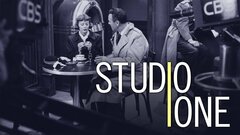Edward R. Murrow

Journalist • Broadcaster
Birth Date: April 25, 1908
Death Date: April 27, 1965 — 57 years old
Birth Place: Greensboro, North Carolina
A pioneer of broadcast journalism, Edward R. Murrow set the bar for integrity in the medium through his famed reporting from Europe during World War II, and later with his uncompromising coverage of national and world events for CBS News. Murrow was largely credited with providing the turning point in national opinion towards Senator Joseph McCarthy's Communist accusations during the Red Scare of the 1950s, though his rise to prominence came at a heavy price. Murrow's steadfast adherence to journalistic ethics and principles led to outspoken criticism of network programming and news coverage, which in turn led to his ouster from the network that he had helped to build in the late 1940s and early 1950s. The path he blazed for generations of news reporters and journalists remained a high-water mark for the medium, as well as a reminder of the duty all journalists shared in presenting the facts of the day in clear, concise and honest terms.
Born Egbert Roscoe Murrow at Polecat Creek in Guilford County, NC on April 25, 1908, he was the son of Quaker parents who raised their three sons in a log cabin without electricity or plumbing. Murrow would later credit his parents' dedication to their faith with informing his intensely ethical viewpoint, which began to develop as a high school student in Edison, WA. There, he served as both president of his student body as well as a skilled debater on the school's team.
Murrow continued to be involved in school politics at Washington State College, where he delivered a convention speech to the National Student Federation of America that urged young people to take an interest in national and world issues. After graduating in 1930, he worked at the Institute of International Education, where he aided displaced German scholars who had been removed from their positions due to the conflict in World War I. In 1935, Murrow became director of talks and education for the CBS network, for which he would coordinate appearances by political and social commentators. A former speech major, Murrow began studying the on-air delivery of announcer Bob Trout, and would apply these new skills after heading to Europe to serve as director of the network's operations there.
Murrow's journalistic career began with the dawn of World War II, where he developed the first live multipoint reporting from various sites across Europe to cover the annexation of Austria by Adolf Hitler. In 1938, he assembled a cadre of international journalists to cover the event from various locations across the continent for the "European News Report," the first live multipoint coverage on the radio. Murrow himself reported from Vienna, and would continue to provide uncensored, improvised and highly evocative reporting of the London Blitz during 1939 - again, the first of its kind for the medium, which prior to Murrow, had broadcast the news via a studio announcer, who read incoming reports. Murrow's reporting, which reached dramatic heights with his signature introduction of "This is London," minted him as a pioneer in broadcast journalism.
With the conclusion of the European Theater and launch of the war in the Pacific, Murrow expanded CBS London with a team of stellar reporters, including such future stars of the medium as Eric Sevareid, Howard K. Smith, Bill Downs and Charles Collingwood. Among their accomplishments during this period was the first reporting from a Nazi concentration camp in Germany, where Murrow depicted the horrors of the scene in harrowing details.
After the war, Murrow was briefly appointed head of CBS News, but left the position to return to broadcasting as anchor of the 7:45 p.m. Eastern newscast. From 1951 to 1955, he hosted "This I Believe" (CBS Radio, 1951-55) a series of five-minute essays penned by famous and everyday citizens alike about their personal motivations, as well as "Hear it Now" (CBS Radio, 1950-51), a weekly radio news magazine produced by Murrow and Fred W. Friendly.
The series came to network television in 1951 as "See it Now." Its celebrated seven-year run, which amassed four Emmys and a Peabody Award, tackled controversial topics on a regular basis, but entered the realm of history for its 1954 telecast about Senator Joseph McCarthy's pursuit of alleged Communists in American society. Murrow and Friendly were prevented from using the CBS logo or network funds to promote the episode, and paid for its advertising themselves. The broadcast was a landmark moment in American television, turning not only popular opinion against McCarthy's witch hunt, but also giving credence and character to a medium largely considered by audiences and critics alike as lacking the moral fiber of its print and radio predecessors.
During this period, Murrow also hosted "Person to Person" (CBS, 1953-59), an informal but Emmy-winning talk show that featured the broadcaster in conversation with various figures from politics and entertainment in their own homes.
However, Murrow's hard-hitting approach to the news did not endear him to network executives. "See it Now" was only an occasional ratings hit, and when the quiz show phenomenon of the 1950s reached full blossom, its sponsors withdrew their funding, and the show was relegated to occasional specials. Murrow took these actions personally, which placed him in direct conflict with CBS chairman Bill Paley. His speech at the Radio and Television News Directors Association in 1958 that lambasted television's trend towards entertainment and commercial gain over news permanently damaged Paley's relationship with Murrow. He was dispatched to the short-lived "Small World" (1958-59), which, despite its groundbreaking technological advancements in connecting political figures from across the globe for one-on-one debates, failed to generate an audience.
After contributing to the first episodes of the news documentary series "CBS Reports" (CBS, 1959-1981), Murrow stepped away from television due to the mounting stress from his battles with the network. In 1961, he resigned from CBS to accept President John F. Kennedy's offer to head the United States Information Agency, which oversaw the Voice of America broadcasts and other national public relations efforts. The position granted him considerable access to the Oval Office, where he consulted with Kennedy and President Lyndon Johnson on a variety of subjects, most notably the Cuban Missile Crisis in 1962.
However, Murrow's prodigious cigarette habit - he smoked over 60 cigarettes a day and was rarely seen on-air without one in hand - had resulted in lung cancer, which required the removal of his left lung and diminished ability to carry out his task with the Information Agency. He resigned in 1964 and died the following year on April 27. His distinguished career was paid tribute with the creation of the Edward R. Murrow Center of Public Diplomacy at Tufts University and the Edward R. Murrow Communications Center at his alma mater, which later renamed its department of communications as the Edward R. Murrow College of Communication.
In 1971, the Radio and Television News Directors Association established the Edward R. Murrow Award, which honored outstanding achievement in electronic journalism. Murrow was twice portrayed on screen, first by Daniel J. Travanti in the HBO made-for-cable film "Murrow" (1986) and later by David Strathairn in an Oscar-nominated turn in George Clooney's black-and-white drama "Good Night and Good Luck" (2005). By Paul Gaita
Credits

Satchmo the Great

Person to Person

See It Now

What's My Line?Stream



